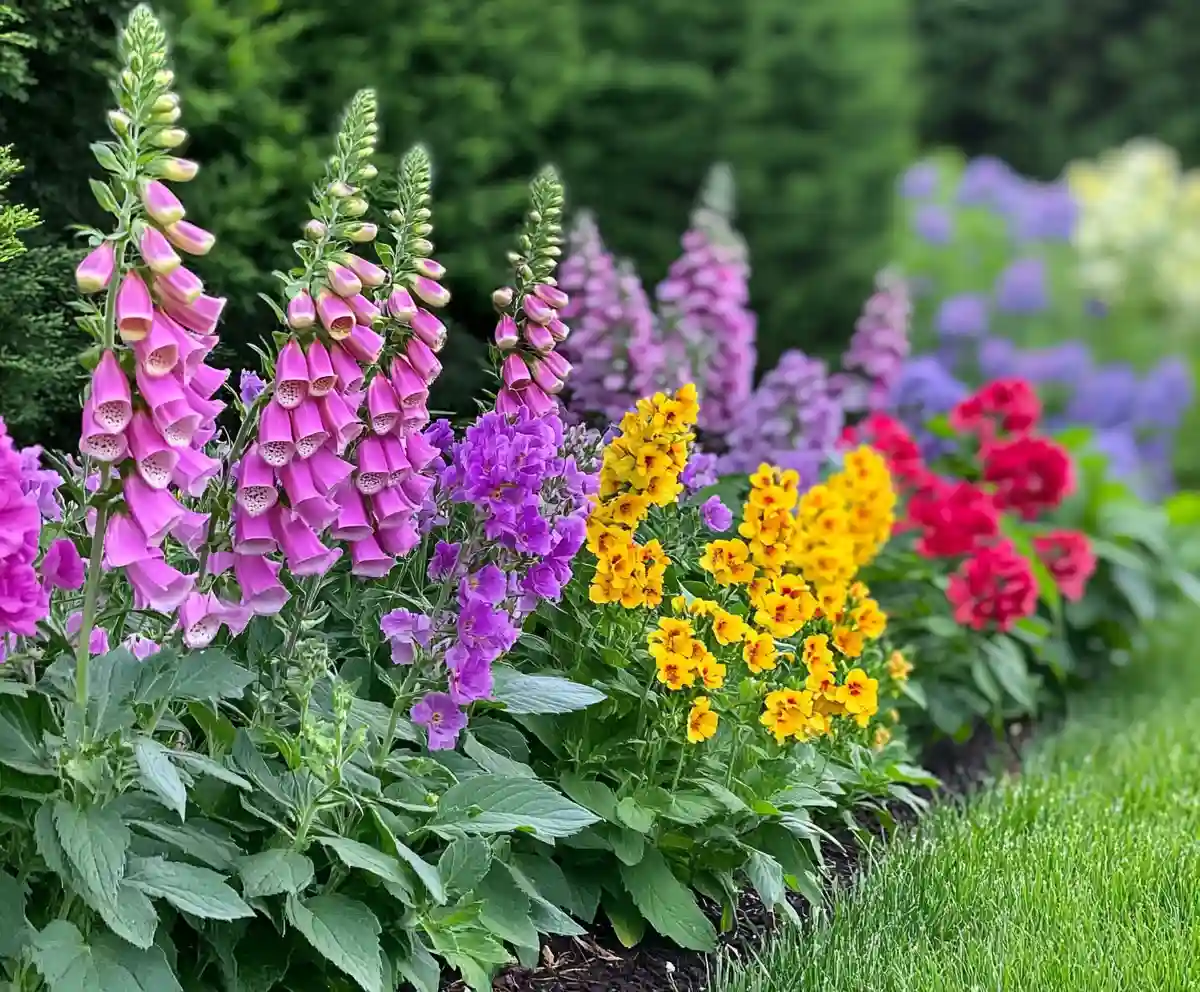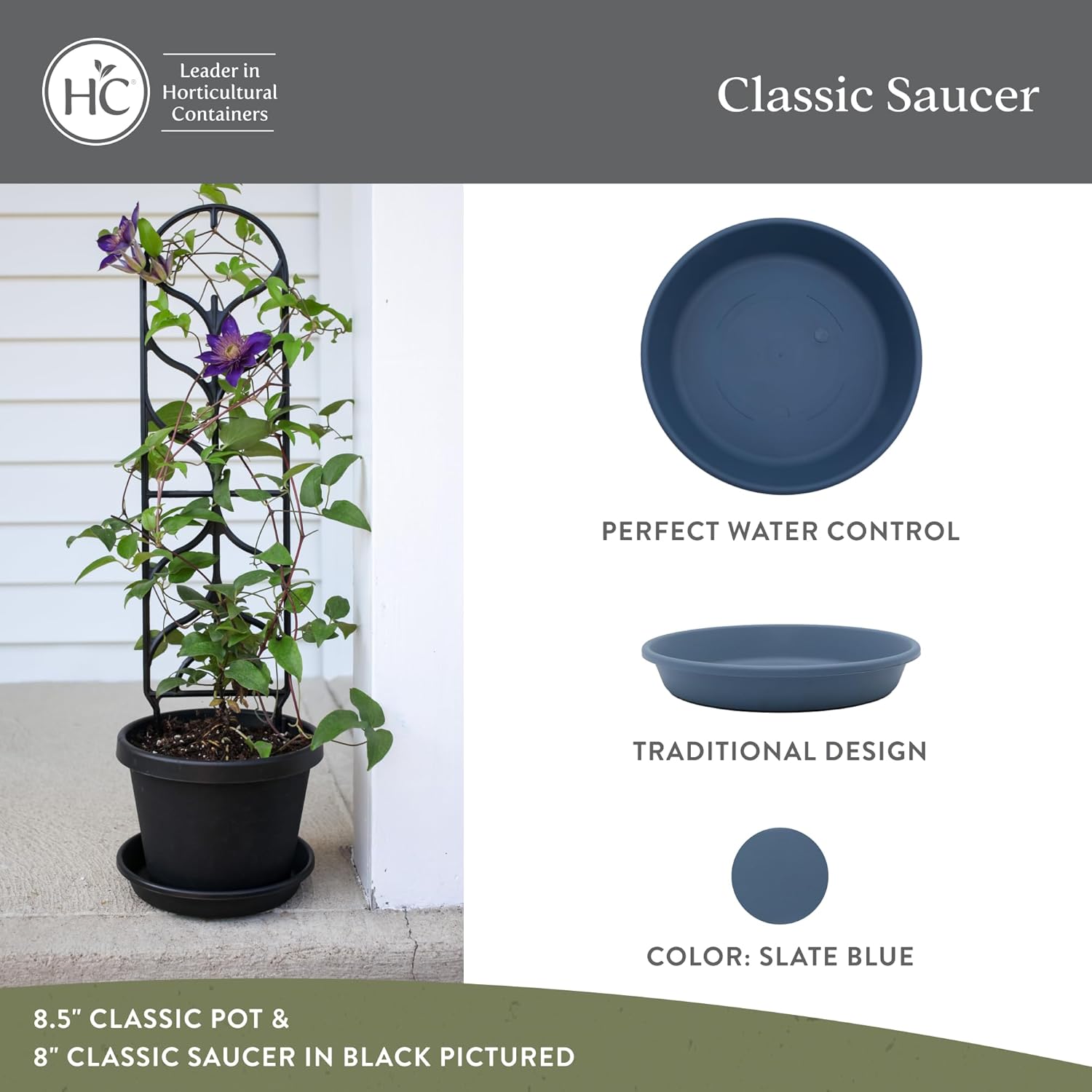Lupines (Lupinus spp.), often mistaken for wildflowers, are dazzling additions to any garden, thanks to their upright spires of pea-like blooms in hues ranging from rich purples to soft pinks and creamy whites. These striking perennials (sometimes grown as annuals) bring charm, color, and pollinator activity to your outdoor space—especially when planted in cooler climates.
Whether you’re looking to fill in a cottage-style border, establish a pollinator-friendly area, or simply enjoy their architectural flair, learning how to grow lupine successfully starts with understanding their needs from soil to sunlight. In this guide, you’ll discover expert tips on planting, caring for, and maximizing blooms from these eye-catching flowers.
Looking to expand your garden’s aesthetic even further? Check out Create an English Garden with These 14 Classic Flowers. This companion guide offers creative inspiration and practical advice for blending lupines with traditional English garden blooms, helping you craft a harmonious, visually stunning outdoor retreat that celebrates classic charm and vibrant seasonal color.
🌱 Lupine Care: Key Tips for Thriving Plants
Growing lupine successfully is all about mimicking its natural environment—sunny meadows with well-drained soil and cool temperatures. Once established, lupines are relatively low-maintenance, but giving them the right start and a bit of attention during the growing season can lead to healthier plants and more vibrant blooms.
Here’s how to care for lupines like a pro:
🕓 When to Plant
- Best seasons: Early spring or fall when temperatures are cool
- Why: Lupines prefer establishing roots in cooler soil before the heat of summer
🌿 Soil Conditions
- Ideal soil: Loose, sandy, or well-draining loam
- pH preference: Neutral to slightly acidic
- Avoid: Heavy clay unless amended with compost or sand for drainage
💡 Pro Tip: Add compost before planting to improve drainage and nutrient content without overwhelming the plant with fertilizer.
☀️ Sunlight Requirements
- Preferred light: Full sun (at least 6 hours a day)
- Tolerates: Partial shade, though blooms may be fewer
- Hot climates: Provide light afternoon shade if summers are intense
💧 Watering Schedule
- Consistency is key: Water weekly during dry periods
- Drainage matters: Soggy roots can lead to rot
- Mulching: Helps retain moisture and regulate root temperature
🌸 Deadheading & Maintenance
- Why deadhead? Encourages more blooms and prevents seed drop
- Support tall varieties: Use stakes or grow-through grids to prevent flopping
🧪 Fertilizing Lupine
- Skip the heavy feeding: Too much nitrogen = fewer flowers
- Use instead: Phosphorus-rich or acidifying fertilizer if soil is too alkaline
🌼 How to Plant Lupine: Step-by-Step Guide
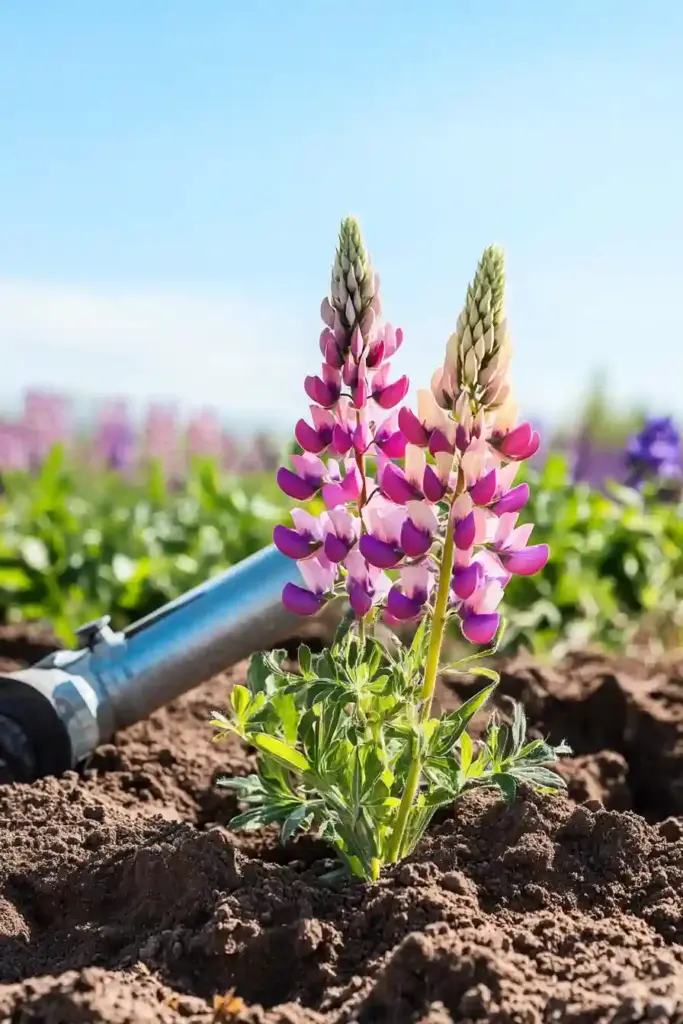
Whether you’re starting from seed or transplanting young plants, planting lupines properly is the first step toward a vibrant and long-lasting display. These tall bloomers thrive when given the right spacing and soil prep from the beginning.
🧤 Tools & Materials
- Garden spade or trowel
- Compost or sand (for soil amendment)
- Mulch
- Watering can or hose
📋 Step-by-Step Planting Instructions
- Choose the Right Spot
- Pick a sunny location with well-drained soil.
- Avoid areas with heavy clay or standing water.
- Prep the Soil
- Dig holes about 12–18 inches deep to accommodate the lupine’s long taproot.
- Mix in compost or sand to loosen dense soil and improve drainage.
- Space Appropriately
- Small varieties: 12 inches apart
- Tall types: 24–36 inches apart
- Plant Carefully
- Gently remove lupine starts from containers.
- Set them into the holes at the same depth as their nursery containers.
- Water Thoroughly
- Give them a deep soak right after planting.
- Keep the soil consistently moist (not soggy) while plants establish.
- Add Mulch
- Apply a thin layer of mulch around the base to retain moisture and discourage weeds.
💡 Pro Tip: Avoid fertilizing at planting—lupines fix their own nitrogen and prefer lean soils.
☀️ Light, Soil & Water: Creating the Ideal Environment for Lupines
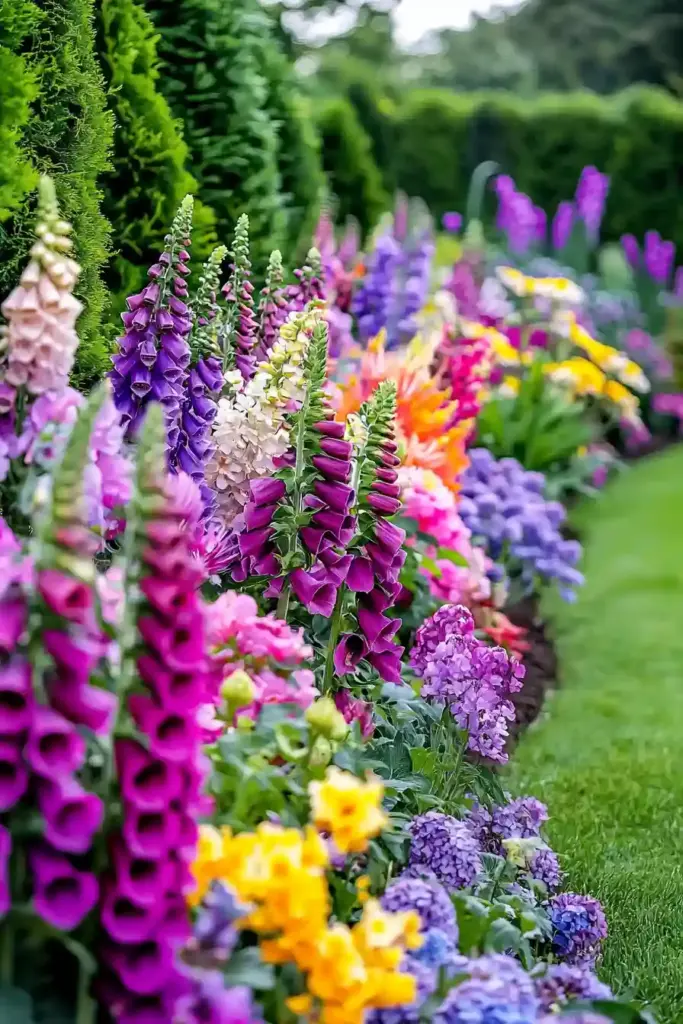
Lupines are hardy yet particular plants. Giving them the right mix of sun, soil, and moisture makes all the difference when it comes to growth and bloom quality. Here’s how to fine-tune their growing conditions for the best results.
🌞 Light Requirements
- Full Sun Is Best: Aim for 6–8 hours of direct sunlight daily.
- Partial Shade Tolerance: They can tolerate some shade, but it may reduce flowering.
- Hot Zones Tip: In regions with scorching summers, offer afternoon shade to protect blooms from fading.
🌱 Soil Preferences
- Drainage is Crucial: Lupines hate “wet feet.” Sandy or loamy soils are perfect.
- Soil pH: Slightly acidic to neutral (6.0–7.0 is ideal).
- Amending Heavy Soil: Mix in sand or compost to lighten dense clay.
🌿 Bonus Tip: Lupines naturally improve soil health by fixing nitrogen, making them great companions in mixed flower beds or pollinator gardens.
💧 Watering Guidelines
- Keep It Consistent: Water once per week if there’s no rainfall.
- Avoid Overwatering: Let the top inch of soil dry out between watering sessions.
- Mulch Matters: A light layer of organic mulch helps retain moisture and keep roots cool—especially helpful in warmer climates.
🌿 Is Lupine Right for Your Garden?
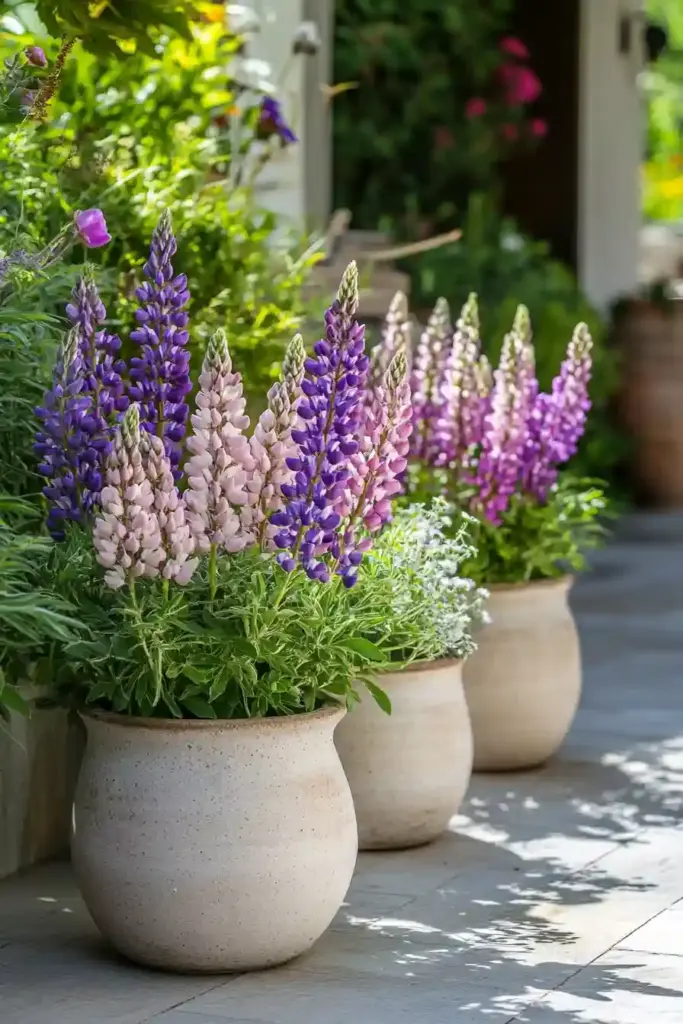
Before diving in and planting a patch of lupines, it’s smart to make sure they’re a good fit for your garden’s conditions—and your household. While they’re easy to grow and undeniably stunning, there are a few key things to consider.
✅ Lupines Are a Great Choice If:
- You have cool to moderate summer temperatures
- Your garden offers full sun and well-draining soil
- You’re looking for a low-maintenance, pollinator-friendly plant
- You enjoy growing from seed or propagation
- You don’t have curious pets or young children—lupines are toxic if ingested
⚠️ When to Think Twice:
- You live in hot, humid regions where lupines tend to struggle
- You have heavy clay soil and no way to amend it
- You want a long-living perennial—lupines typically live 2–5 years
- You’re concerned about plant toxicity—lupine seeds and foliage are poisonous to people and pets
🐝 Bonus Benefit: Lupines are deer-resistant and attract bees and butterflies, making them excellent for wildlife gardens.
🌈 Popular Lupine Varieties for Every Garden Style
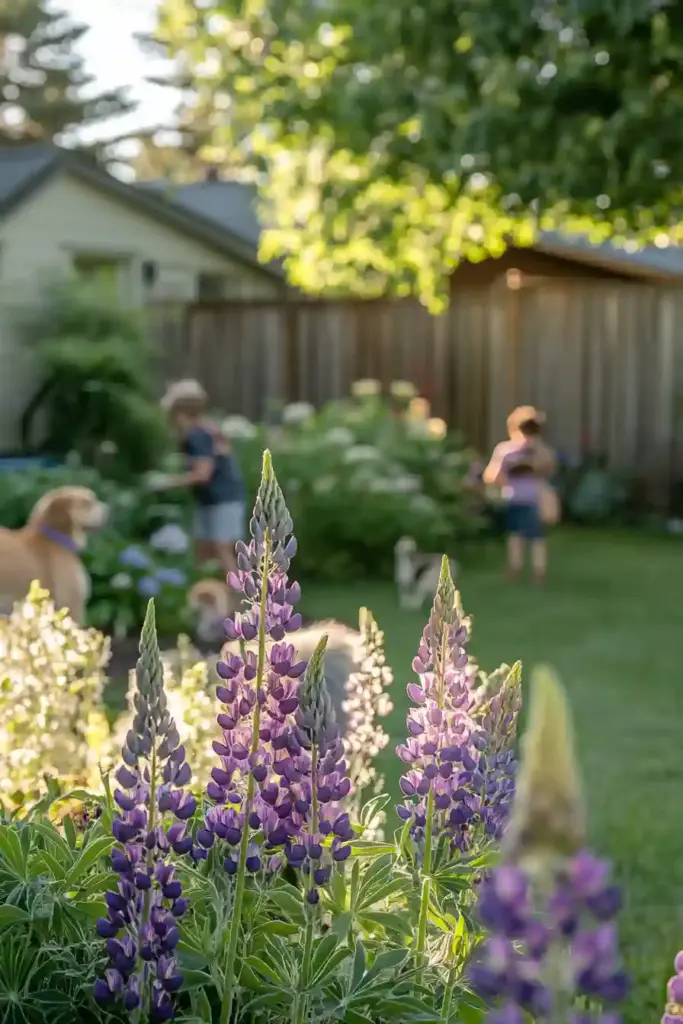
One of the joys of growing lupine is the sheer range of colors, sizes, and styles available. From classic blues to bold bicolors and compact cultivars perfect for containers, there’s a lupine for every gardener.
Here are some standout varieties to consider:
🎨 Rainbow of Options
- Russell Hybrids
- Height: 3–4 feet
- Colors: A vibrant mix of blues, purples, pinks, yellows, and bicolors
- Great for: Mass plantings and dramatic borders
- Fun fact: Bred in the 1930s, these are the foundation for most modern cultivars.
- Gallery Series
- Height: Up to 2 feet
- Ideal for: Small gardens or containers
- Colors: Includes shades like white, red, pink, and purple
- Notable cultivar: ‘Gallery White’ for crisp, elegant blooms
- Dwarf Lulu Mix
- Height: About 2 feet
- Features: Dense flower clusters and compact growth
- Perfect for: Edging pathways and lower beds
🏵️ Native & Specialty Varieties
- Lupinus albus (White Lupine)
- Height: Up to 4 feet
- Use: Sometimes grown for agricultural soil improvement
- Blooms: Pure white, ideal for moon gardens
- Lupinus angustifolius (Blue Lupine)
- Height: Up to 5 feet
- Use: More common in farming than ornamental gardening
- Note: Excellent nitrogen fixer
- Lupinus albifrons (Silver Lupine)
- Height: 3–5 feet
- Features: Silver-green foliage with bluish-purple blooms
- Great for: Native plant gardens and xeriscaping
🌟 Tip for Garden Design: Combine tall and dwarf varieties to create depth and layering in flower beds.
🌱 How to Propagate Lupines: Seeds vs. Cuttings
Lupines are surprisingly easy to propagate, whether you’re starting fresh from seed or extending the life of a favorite plant through cuttings. Both methods have their benefits, and knowing when and how to use each can help you maintain a vibrant lupine display year after year.
🌼 Growing Lupines from Seed
Seed propagation is the most common method—and often the most rewarding. While it takes a bit longer for blooms to appear, lupines grown from seed are hardy and establish well when planted correctly.
✅ How to Start from Seed:
- Scarify the Seeds
- Lupine seeds have a tough outer coating. Gently nick with a file or rub with sandpaper.
- Or soak them overnight in water to soften.
- Plant Directly Outdoors
- Best time: Early spring or fall
- Depth: ¼ inch deep
- Choose a sunny, permanent spot (they don’t transplant well due to their deep taproot)
- Germination Time: 2–4 weeks depending on soil temperature and moisture
🌱 Patience pays off: Seed-grown lupines often take up to two years to bloom—but the results are worth the wait.
🌿 Propagating by Cuttings
If you already have a healthy lupine and want to clone it (especially a prized hybrid), propagation by basal cuttings is a great option.
✂️ How to Take Cuttings:
- Time it Right: Early spring, before the plant fully leafs out
- Select a Basal Shoot: Look for a sturdy, emerging shoot at the plant’s base
- Use a Sharp Knife: Sanitize the blade and cut just below the crown
- Replant Immediately: In a new location with well-drained soil and full sun
🔁 Refresh your patch: Repeat every 2–3 years since lupines are short-lived perennials.
🪴 How to Grow Lupines in Pots or Containers
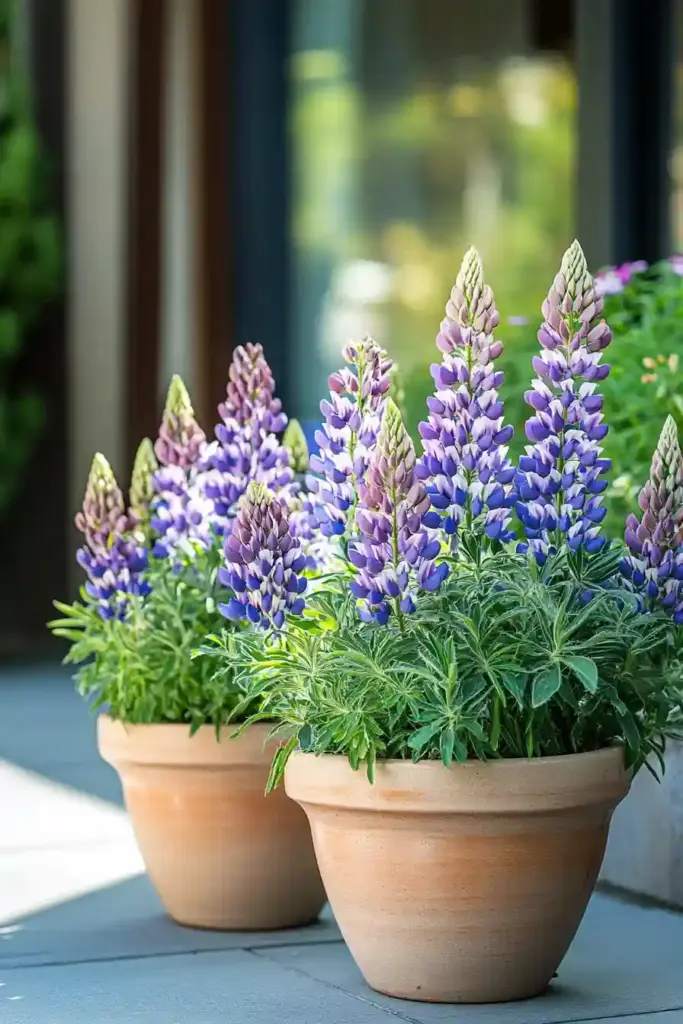
Think lupines are only for garden beds? Think again. With the right container and a bit of care, you can grow these vertical beauties on patios, decks, or balconies. Container planting is also a great solution if your soil isn’t ideal or you’re working with limited space.
🏺 Choosing the Right Container
- Size matters: Use a deep, heavy container—at least 12–18 inches deep—to accommodate lupines’ long taproots
- Drainage is key: Ensure the pot has good drainage holes to prevent root rot
- Material tip: Terracotta or ceramic pots help regulate soil moisture better than plastic
🌱 Potting & Planting Tips
- Use well-draining soil
- A mix of garden soil, sand, and compost works well
- Spacing
- One plant per pot unless using a very large container
- Space at least 12 inches apart in wide planters
- Sunlight
- Place your container where it will receive full sun most of the day
- Watering
- Container plants dry out faster—check soil moisture regularly
- Water deeply when the top inch of soil feels dry
- Winter Care
- In cold climates, cut back plants in fall, move pots to a sheltered area (like a garage), and mulch to protect roots
🌸 Best varieties for pots: Dwarf cultivars like ‘Gallery Series’ or ‘Dwarf Lulu’ are compact and container-friendly.
❄️ Overwintering Lupines: Cold Weather Care Tips
Lupines are perennials in many regions, meaning they’ll return each spring—if properly protected through winter. While they’re relatively hardy, taking a few simple steps in the fall can make all the difference when it comes to keeping your lupines healthy year after year.
🌬️ What Happens in Winter?
As temperatures drop, lupines go dormant, dying back above ground while conserving energy in their deep roots. With the right prep, they’ll wake up ready to grow come spring.
🍂 How to Prepare Lupines for Winter
- Cut Back the Stalks
- Once flowering is done and foliage starts to fade, cut stems down to 1–2 inches above the soil.
- This helps prevent disease and directs the plant’s energy to root preservation.
- Apply Mulch
- Add a 2–3 inch layer of organic mulch (like straw or shredded bark) over the base to insulate roots and stabilize soil temperature.
- Especially important in zones with freeze-thaw cycles.
- Container Lupines
- Move potted lupines to a protected, unheated space (like a shed or garage).
- Water sparingly—just enough to prevent the soil from going bone dry.
🛑 Don’t fertilize in fall: It may stimulate new growth too late in the season, making plants more vulnerable to frost damage.
🐛 Common Pests & Diseases That Affect Lupines
Lupines are generally resilient, but like any garden plant, they can fall victim to a few pesky invaders and plant problems. Knowing what to watch for—and how to act fast—can keep your plants blooming and beautiful all season long.
🐞 Common Lupine Pests
- Aphids
- Symptoms: Sticky residue on leaves, distorted growth
- Solution: Spray with insecticidal soap or neem oil; encourage ladybugs
- Slugs & Snails
- Symptoms: Ragged holes in leaves, especially on young plants
- Solution: Hand-pick at dusk, use slug bait, or set beer traps
- Prevention Tip: Keep garden beds clean and dry around the base of plants
- Leafhoppers
- Symptoms: White stippling on leaves, spread of plant diseases
- Solution: Use row covers early in the season or apply organic insect control methods
🍂 Diseases That Can Affect Lupine
- Lupine Anthracnose(fungal disease)
- Symptoms: Brown spots, wilting stems, curling or blackened leaf tips
- Solution: Remove infected plants immediately and avoid replanting lupines in that spot for a few years
- Powdery Mildew
- Symptoms: White, powdery coating on leaves
- Solution: Improve air circulation, avoid overhead watering, and treat with fungicidal sprays
- Root Rot(caused by overwatering)
- Symptoms: Yellowing leaves, wilting, mushy roots
- Solution: Ensure excellent drainage and reduce watering
🛡️ Prevention is better than cure: Plant in well-drained soil, provide good airflow, and avoid wetting foliage when watering.
🌺 How to Get More Blooms From Your Lupine Plants
There’s nothing quite like a lupine in full bloom—those tall, colorful spires are garden showstoppers. While lupines are naturally prolific, there are a few simple ways to maximize flowering and maybe even coax a second round of blooms later in the season.
🌼 When Do Lupines Bloom?
- Primary bloom: Late spring to early summer (May–July, depending on your zone)
- Rebloom potential: Yes—especially if deadheaded promptly
💡 Bloom-Boosting Tips
- Deadhead Faded Flowers
- Remove spent flower spikes before they set seed
- This encourages the plant to redirect energy into producing new blooms
- Optimize Sunlight
- More sun = more blooms
- If plants are shaded by trees or shrubs, trim back nearby foliage
- Use Phosphorus-Rich Fertilizer
- Choose a “bloom booster” formula with higher phosphorus (P) than nitrogen (N)
- Avoid nitrogen-heavy fertilizers—they promote leafy growth over flowers
- Water Consistently
- Dry spells can stress the plant and reduce flowering
- Keep soil moist but not soggy
- Cut Back After First Bloom
- In midsummer, trim the plant by half after the main bloom ends
- This can trigger a second flush of smaller blooms
🌷 Want longer-lasting color? Plant multiple lupine varieties with staggered bloom times, or combine with other early and mid-summer perennials.
🍂 What to Do With Lupines After They Bloom
Once your lupines have dazzled with their vivid floral spikes, it’s time to transition into post-bloom maintenance. This not only tidies up the garden but can also help extend the plant’s life and possibly even encourage a second round of flowers.
✂️ Deadhead or Let It Seed?
- For More Blooms:
Snip off the spent flower spikes as soon as they fade. This prevents seed formation and encourages a second bloom, especially in cooler climates. - To Collect Seeds:
Allow the seed pods to dry on the plant until they turn brown. Harvest the pods and store seeds in a cool, dry place for next season.
🔁 Caution: Lupine seeds are toxic if ingested—keep them away from pets and children.
🪓 Cut Back for Dormancy
- In late summer or early fall, cut the plant down to the ground, leaving about 1–2 inches of stem.
- This helps prepare the plant for winter dormancy and reduces the chance of pests or disease overwintering in dead foliage.
🌾 Optional: Divide or Replace
Since lupines are short-lived perennials (lasting 2–5 years), consider:
- Dividing healthy plants every 2–3 years to refresh growth
- Replanting from seed or cuttings to maintain a colorful display
🌸 Garden tip: Mix spent lupine areas with later-blooming flowers like echinacea or rudbeckia to maintain summer color.
🛠️ Common Problems and Troubleshooting Tips for Lupines
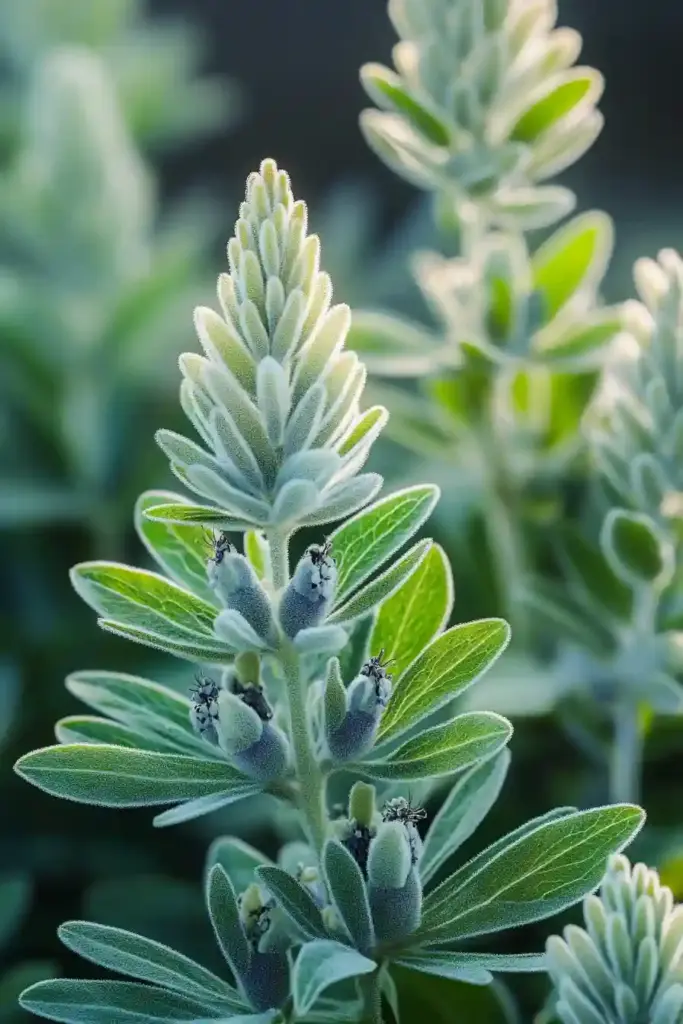
Even though lupines are fairly easygoing, sometimes things go wrong. If your plants aren’t looking their best, here are some of the most common issues—and how to fix them.
🚫 Problem: No Blooms
Possible Causes:
- Not enough sunlight (less than 6 hours daily)
- Too much nitrogen in the soil
- Lack of phosphorus
- Overcrowding or poor air circulation
Fixes:
- Move to a sunnier location or trim nearby trees
- Avoid using nitrogen-rich fertilizer
- Apply a balanced or phosphorus-heavy bloom booster
- Space plants properly and thin out if needed
🍁 Problem: Brown Leaf Tips or Wilting
Possible Causes:
- Fungal disease (like anthracnose)
- Overwatering and poor drainage
- Root rot
Fixes:
- Remove and destroy infected foliage
- Improve soil drainage and avoid watering too frequently
- Apply a fungicide if needed
🐌 Problem: Chewed Leaves or Seedlings Disappearing
Likely Culprits:
- Slugs, snails, or aphids
Fixes:
- Use organic slug bait or beer traps for slugs
- Spray aphids with insecticidal soap
- Keep garden beds tidy and free from mulch buildup right at the base
🧪 Problem: Yellowing Leaves
Possible Causes:
- Overwatering or waterlogged soil
- Nutrient deficiency (especially iron or nitrogen)
- Poor drainage
Fixes:
- Check soil moisture and reduce watering
- Consider a mild, balanced fertilizer
- Amend soil with compost for better structure
🌿 Remember: Healthy lupines start with the right environment. Most problems can be prevented with good drainage, full sun, and occasional TLC.
🌟 Conclusion: A Rewarding Garden Favorite
Lupines are more than just a pretty face—they’re hardy, pollinator-friendly, and bring bold color and vertical drama to any garden. With the right sunlight, well-draining soil, and a little seasonal care, these vibrant bloomers will reward you year after year with their signature spires.
Whether you’re growing from seed, propagating a favorite variety, or planting in containers, lupines offer an accessible and satisfying way to elevate your flower beds or borders. Just don’t forget to deadhead, mulch before winter, and give them room to breathe!
🌱 So go ahead—add some lupine magic to your garden, and enjoy the colors, the bees, and the blooms.

